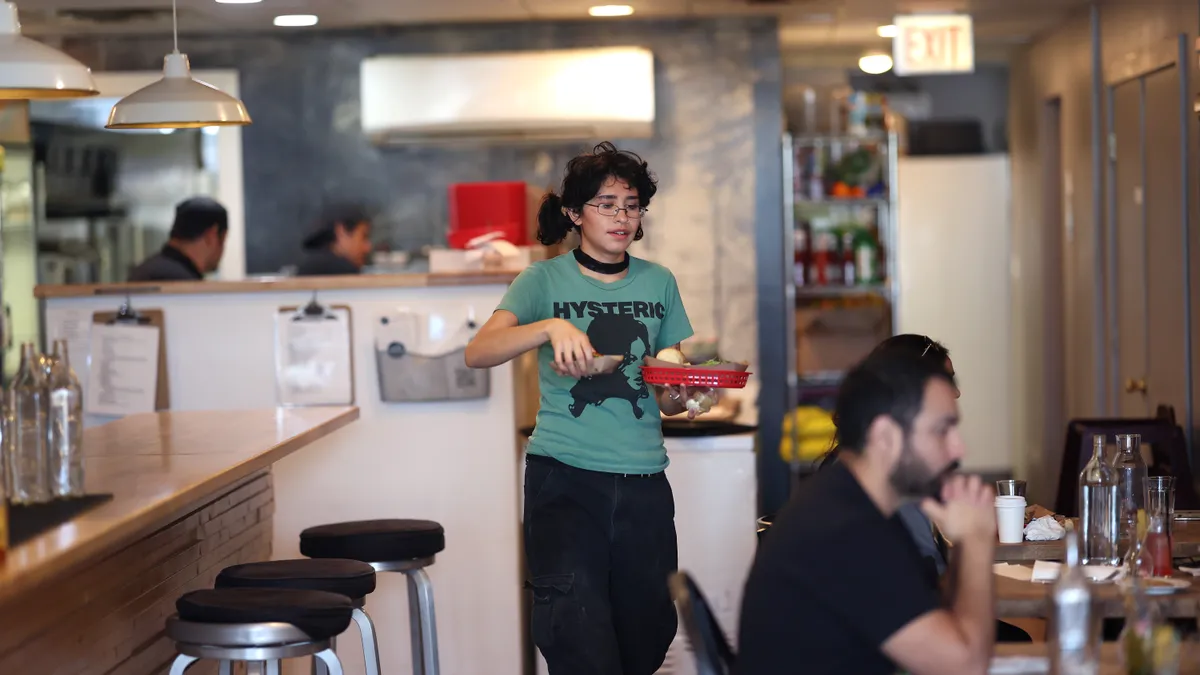Communities of practice are not a new concept for HR professionals. But with emerging tech changing how work is done — and where work is done — some leaders seek to support and grow these employee-driven learning paths. From their perspectives, communities of practice (CoPs) can allow organizations to increase the skill sets of whole employee groups remotely or in person, help them establish then manage bases of specialized knowledge and continuously improve employees' skills as work evolves.
A quick refresher on CoPs
Mark Goldstein, community associate at Philanthropy University, told HR Dive via email that communities of practice are comprised of people with specific skills who want to do them better through social interaction within a group.
The term "communities of practice" was introduced in the early '90s by social learning theorist Etienne Wenger and cognitive anthropologist Jean Lave in their book, "Situated Learning." They coined the name to describe groups of people who share a craft or profession and to further explore learning as a social process. Wenger's "Communities of Practice," published in 1998, expanded on the concept. Both works explored how people learn through hands-on practice and group participation.
Today, these groups can be invaluable to organizations that want skills education to stick, Joe Miller, BenchPrep's VP of learning design and strategy, told HR Dive via email. "We don't learn in a silo, so a lot of engagement and bouncing ideas off each other is how learning happens in the workplace," he explained.
At Philanthropy U, Goldstein said they use communities to encourage peer-to-peer learning and improve organizational effectiveness through the exchange of ideas and best practices. Online communities can be effective, too, whether through internal discussion boards or business messaging platforms like Slack.
"In the past," wrote Miller, "we had to collaborate in person, at conferences and seminars, where people with the same skill sets would show up at the same places; or learn from Q&As with other leaders in print articles." But the web has changed the world, he added. Formal and informal collaboration channels allow workers to ask questions, create groups and have people chime in, respond and solve problems together. "In areas like tech and engineering," he continued, "these things really permeate."
How are they used and implemented?
Within an organization, Goldstein said, CoPs often emerge organically, with employees sharing tips, notes and strategies with one another. "From formal groups to online discussion boards to causal water cooler conversation, CoPs emerge any time motivated people connect with one another over improving a particular activity they are engaged in."
"This could look like employees enrolled in a particular course or program who collaborate together outside the course setting to deepen their knowledge," Kristen Fyfe-Mills, associate director of communications at the Association for Talent Development (ATD), wrote in an email to HR Dive.
Goldstein said businesses can build CoPs intentionally around specific skill areas, but noted that leaders can also support existing CoPs by nurturing their development and encouraging employees to join. When organizational leaders start with CoPs, there are a few routes they can take, he continued. "The first would be simply encouraging employees to share their insights with one another and recognizing employees who have formed CoPs or who are particularly good at sharing their knowledge with their colleagues."
Though CoPs can be a lo-fi learning solution, they still need top-down support to be successful. At BenchPrep, the leaders didn't set up the channels, but rather provided tools that allowed employees to build the channels that worked best for them, Miller said.
Goldstein advised leaders to incentivize participation by putting time aside for the convening of CoP, as well. Although organizations can implement CoPs that don't emerge organically, forced participation is unlikely to result in a valuable experience for participants, said Goldstein. "Similarly," he said, "attempting to have each member of a CoP contribute equally is misguided, as a strong CoP is valuable to different types of members, from the most active participants to those that choose to participate passively."
Finding the right balance between supporting CoPs and dictating their operations is not always easy, but it's worth it, according to Miller.
"Provide opportunities for professional development," said Miller, "but don't make it self-serving, so it only benefits the company. You want to be somewhat hands-off – support and encourage it, but don't prescribe how the interactions should take place. A company that understands not to be pushy but let these things organically grow is taking a smart approach."
How do they benefit businesses?
Just as online forums for consumers become knowledge bases for future inquiries, so do CoPs become a source of always-evolving specialty knowledge for businesses. By developing individual employee knowledge and skill, and then turning that knowledge into organizational learning, CoPs can contribute to positive business outcomes, Fyfe-Mills said. In a piece on the subject, ATD said the creation of subject matter networks is just one positive outcome of CoPs.
Managing knowledge this way, Goldstein said, is especially helpful for improving on tacit skills, which can be difficult to convey through writing or a training program. Another bonus: "They also support employees building social capital and forming a stronger connection with their colleagues," he said.
Evaluating their effectiveness
As with any L&D effort, said Fyfe-Mills, it is important to "know what success looks like" when starting out with CoPs. Some companies define success as the cost savings realized by their CoPs, and others may see gains in efficiency, productivity or effectiveness, she said.
Philanthropy U spends a lot of time thinking about how to measure the value and success of such experiential learning, Goldstein said. "[The] truth is" he said, "it can be really challenging, especially in a virtual setting. Sometimes success can be obvious: Participants in a CoP perform better and teams are more efficient. Other times, you have to rely on indicators of participation like the rate of meetings to share ideas, reflections, and questions."
For a more data-driven approach, he said, leaders can use surveys to measure "sense of community" and other self-reported metrics to understand how valuable employees feel CoPs have been to their work or how much they've enjoyed participating.



















